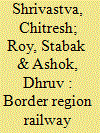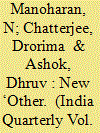|
|
|
Sort Order |
|
|
|
Items / Page
|
|
|
|
|
|
|
| Srl | Item |
| 1 |
ID:
190745


|
|
|
|
|
| Summary/Abstract |
India and China share about 3,488 km long International Boundary, which has three sectors: Western, Middle and Eastern. The Eastern sector comprises two Northeastern states, that is, Arunachal Pradesh measuring 1,124 kms and Sikkim measuring 219 kms, respectively. Due to recent changes in the geopolitical relationship with China, border management and transport infrastructure development have occupied centre stage. In recent years, the Government of India has taken initiatives to develop railway infrastructure in Northeast India. The study will focus on the role of railway transportation in Sino-Indian geopolitical competition. The study is based on secondary data collected from the office of General Manager, Northeast Frontier Railway, the Census of India and reports of Memorandums of Understanding between India and China. The study reveals that railway infrastructure along the border creates geo-psychological pressures on both countries, influencing the divergent geopolitical relationship between India and China. Railway diplomacy is a tool kit of critical geopolitics which reveals the contours of geopolitical competition in borderlands.
|
|
|
|
|
|
|
|
|
|
|
|
|
|
|
|
| 2 |
ID:
182610


|
|
|
|
|
| Summary/Abstract |
One of the key terms to understand the nature of violence and conflicts world over is ‘radicalisation’. Sri Lanka’s case is instructive in understanding the various dimensions of Islamic radicalisation and de-radicalisation, especially in South Asia. Though a small state, Sri Lanka has witnessed three radical movements, the latest being Islamic that got manifested in deadly Easter attacks of April 2019. Eco-space for Islamic radicalisation existed in the island for decades, but the rise of ultra-Sinhala-Buddhist nationalism post the end of Eelam War IV acted as a breaking point. The underlying context is perceived as the feeling of insecurity projected by hardline Sinhala-Buddhist elements. In due course, the primary ‘other’ shifted from Tamils to Sri Lankan Muslims. Apart from inter-communal dissonance, international jihadist network also fostered radicalisation process in the island’s Muslim community. Political instability due to co-habitation issues between the then president and the prime minister was a perfect distraction from the core security and development issues. In response to the violent manifestation of radicalisation, de-radicalisation measures by the successive Sri Lankan governments were mostly military in nature. Socio-economic and political components of Islamic de-radicalisation are at the incipient stage, if not totally missing. The article suggests wide-ranging measures to address the issue of radicalisation in the island state.
|
|
|
|
|
|
|
|
|
|
|
|
|
|
|
|
|
|
|
|
|